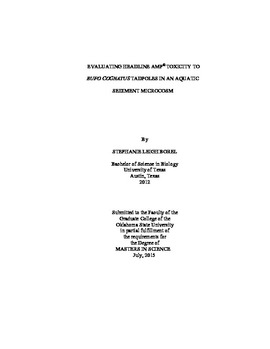| dc.description.abstract | Increased use of strobilurin fungicides has expanded the potential for exposure to non-target wetland organisms. An acute toxicity test was performed to compare the toxicity of Headline AMP® to Great Plains toad (Bufo cognatus) tadpoles in a water only exposure, and two aquatic sediment microcosms that differ in their texture class and organic matter (OM) content (Nebraska sediment, 6.14% OM, silty clay loam; Texas sediment, 4.15% OM, clay loam). The sediments were predicted to sequester the fungicide at variable rates, thus affecting the exposure and toxicity of the fungicide. Following the acute toxicity test, a fate study was performed to examine partitioning and bioavailability of pyraclostrobin, the active ingredient in Headline AMP®. Ninety-five percent of all tadpole mortalities in the water only exposures occurred within the first 6 hours. Tadpole nominal LC50 values were 8.0 µg/L for water-only exposures, 9.3 µg/L for the Texas sediment system, and 15.3 µg/L for the Nebraska sediment system. Differences in LC50s suggest that Nebraska sediments are more protective than Texas sediments and the water only system. In the fate study, pyraclostrobin dissipated from the water gradually, with mean (±SE) total percent recovery from water at 90±4% at 2 hours to 18±4% at 72 hours for Nebraska sediment. Recovery of pyraclostrobin from water decreased quicker in the Texas sediment system, from 72±2% at 2 hours to 20±3% at 72 hours. Texas sediment treatments averaged 3.8±0.7 times as much suspended sediment as compared to Nebraska sediment treatments. The increased suspended solids in the Texas treatment resulted in more sequestration of analyte by sediments, averaging 30±21% over the course of 72 hr. Tadpoles present during an application of Headline AMP® are at risk of exposure to a lethal dose by spray drift, field runoff, or direct overspray, even at fractions of the label rate, before suspended sediments are able to ameliorate toxicity. Further, different species of amphibians will have different levels of risk based on their species-specific larval periods. Lastly, land use affects deposition, suspension, and texture of sediments in wetlands and thus, can influence partitioning of fungicide to the sediments and exposure scenarios for organisms. | |
